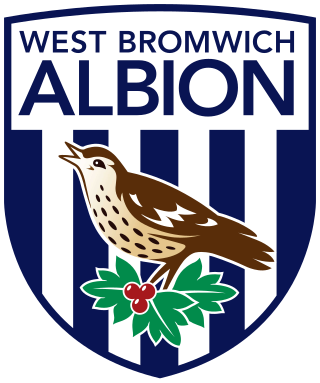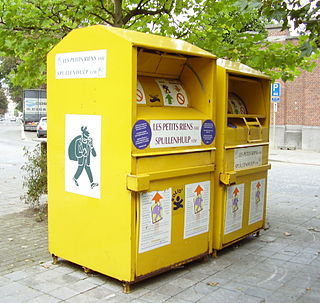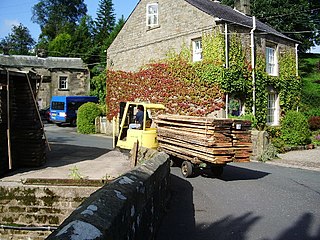
West Bromwich Albion Football Club is a professional football club based in West Bromwich, West Midlands, England. It competes in the EFL Championship, the second tier of English football. The club was formed in 1878 and has played at its home ground, The Hawthorns, since 1900.
The Hawthorns is an all-seater football stadium in West Bromwich, West Midlands, England, with a capacity of 26,688. It has been the home of Championship club West Bromwich Albion since 1900, when it became the sixth ground to be used by the club. The Hawthorns was the first Football League ground to be built in the 20th century, opening in September 1900 after construction work took only 4 months. The official record attendance at The Hawthorns stands at 64,815, set in 1937.

Flannel is a soft woven fabric, of varying fineness. Flannel was originally made from carded wool or worsted yarn, but is now often made from either wool, cotton, or synthetic fiber. Flannel is commonly used to make tartan clothing, blankets, bed sheets, and sleepwear.

Cotton-spinning machinery is machines which process prepared cotton roving into workable yarn or thread. Such machinery can be dated back centuries. During the 18th and 19th centuries, as part of the Industrial Revolution cotton-spinning machinery was developed to bring mass production to the cotton industry. Cotton spinning machinery was installed in large factories, commonly known as cotton mills.
Bernina International AG is a privately owned international manufacturer of sewing and embroidery systems. The company was founded in Steckborn, Switzerland, by a Swiss inventor Fritz Gegauf. The company develops, manufactures, and sells goods and services for the textile market, primarily household sewing-related products in the fields of embroidery, quilting, home textiles, garment sewing, and crafting. The origins of the company lie in the invention of the hemstitch sewing machine, invented in 1893 by a Swiss inventor and entrepreneur Karl Friedrich Gegauf. Currently, the company's products include sewing machines, embroidery machines, serger/overlocker machines, and computer software for embroidery design.

Platt Brothers, also known as Platt Bros & Co Ltd, was a British company based at Werneth in Oldham, North West England. The company manufactured textile machinery and were iron founders and colliery proprietors. By the end of the 19th century, the company had become the largest textile machinery manufacturer in the world, employing more than 12,000 workers.

Navajo weaving are textiles produced by Navajo people, who are based near the Four Corners area of the United States. Navajo textiles are highly regarded and have been sought after as trade items for more than 150 years. Commercial production of handwoven blankets and rugs has been an important element of the Navajo economy. As one art historian wrote, "Classic Navajo serapes at their finest equal the delicacy and sophistication of any pre-mechanical loom-woven textile in the world."

Textile recycling is the process of recovering fiber, yarn, or fabric and reprocessing the material into new, useful products. Textile waste is split into pre-consumer and post-consumer waste and is sorted into five different categories derived from a pyramid model. Textiles can be either reused or mechanically/chemically recycled.

Bamboo textile is any cloth, yarn or clothing made from bamboo fibres. While historically used only for structural elements, such as bustles and the ribs of corsets, in recent years different technologies have been developed that allow bamboo fibre to be used for a wide range of textile and fashion applications.

Edward McKnight Kauffer was an American artist and graphic designer who lived for much of his life in the United Kingdom. He worked mainly in poster art, but was also active as a painter, book illustrator and theatre designer.

Ring spinning is a spindle-based method of spinning fibres, such as cotton, flax or wool, to make a yarn. The ring frame developed from the throstle frame, which in its turn was a descendant of Arkwright's water frame. Ring spinning is a continuous process, unlike mule spinning which uses an intermittent action. In ring spinning, the roving is first attenuated by using drawing rollers, then spun and wound around a rotating spindle which in its turn is contained within an independently rotating ring flyer. Traditionally ring frames could only be used for the coarser counts, but they could be attended by semi-skilled labour.

The Bradford Durfee College of Technology was a college located in Fall River, Massachusetts. It was chartered in 1895 as the Bradford Durfee Textile School. It was then incorporated in 1899 and opened in 1904. The school was named after Bradford Durfee (1788-1843), a leading early Fall River industrialist.

Cotton recycling is the process of converting cotton fabric into fibers that can be reused into other textile products.

Kirk Mill is an early example of an Arkwright-type cotton mill and a grade II listed building in Chipping, Lancashire, in Ribble Valley, to the north of Preston, Lancashire, England. It was built in the 1780s on the site of a corn mill dating from at least 1544. The mill continued spinning cotton using water frames and then throstles until 1886, when it was sold and became HJ Berry's chairmaking factory. It was powered by a 32 ft (9.8 m) waterwheel which continued in use, generating electricity until the 1940s.

Ashley Havinden (1903–1973) was an influential British graphic designer in the mid twentieth century, specializing in posters, advertisements, logos and typography, he was also a textile and rug designer. In 1947 he was appointed a Royal Designer for Industry.

A textile conservator is a conservator-restorer charged with the care, treatment, research, and preservation of textiles. Issues addressed by a textile conservator are generally related to the field of textile preservation, and include damage caused to textiles by: light, mold and mildew, insects, cleaning, surface cleaning, washing, mounting for display, and storage. Variations in textile types and “the diversity of the textile conservator’s work makes it a very rewarding profession”. Textiles are among the most fragile artifacts, as they are susceptible to damage from atmospheric pollutants, moisture, biological organisms, and environmental changes and care varies with size, shape, material, and condition issues, all of which a textile conservator must be well versed.

The conservation and restoration of flags and banners is the process by which conservators work to preserve and restore flags and banners from future deterioration and damage. As a part of Conservation of Textiles, flag and banner conservation require the care of a skilled and well trained textile conservator, specifically trained in historical materials.
Throstle (1891–1910) was a British Thoroughbred racehorse and broodmare. Born partially blind and considered a likely candidate for euthanasia as a foal she nevertheless proved herself one of the two best fillies of her generation in Britain. She showed considerable promise despite failing to win in three starts as a juvenile in 1893 and began her second season by running sixth to Amiable in the 1000 Guineas. In the summer of her second season she made rapid progress, winning the Coronation Stakes and Nassau Stakes as well as finishing fourth against very strong male opposition in the Eclipse Stakes. Poor form in training led to her starting at odds of 50/1 for the St Leger but she created a huge upset by defeating the Epsom Derby winner Ladas. She failed to win again and was retired from racing in 1895. She had little success as a dam of winners.
Stockport Card, Blowing and Ring Room Operatives' Association was a trade union representing cotton industry workers in the Stockport area of Cheshire in England.
Cowasjee Nanabhai Davar(1815-1873) is known for his pioneering efforts in laying the foundation of the cotton industry in India. He established multiple cotton mills in India. The first was Bombay Spinning and Weaving Company, and another was the Bombay Throstle mill company in Bombay.
















